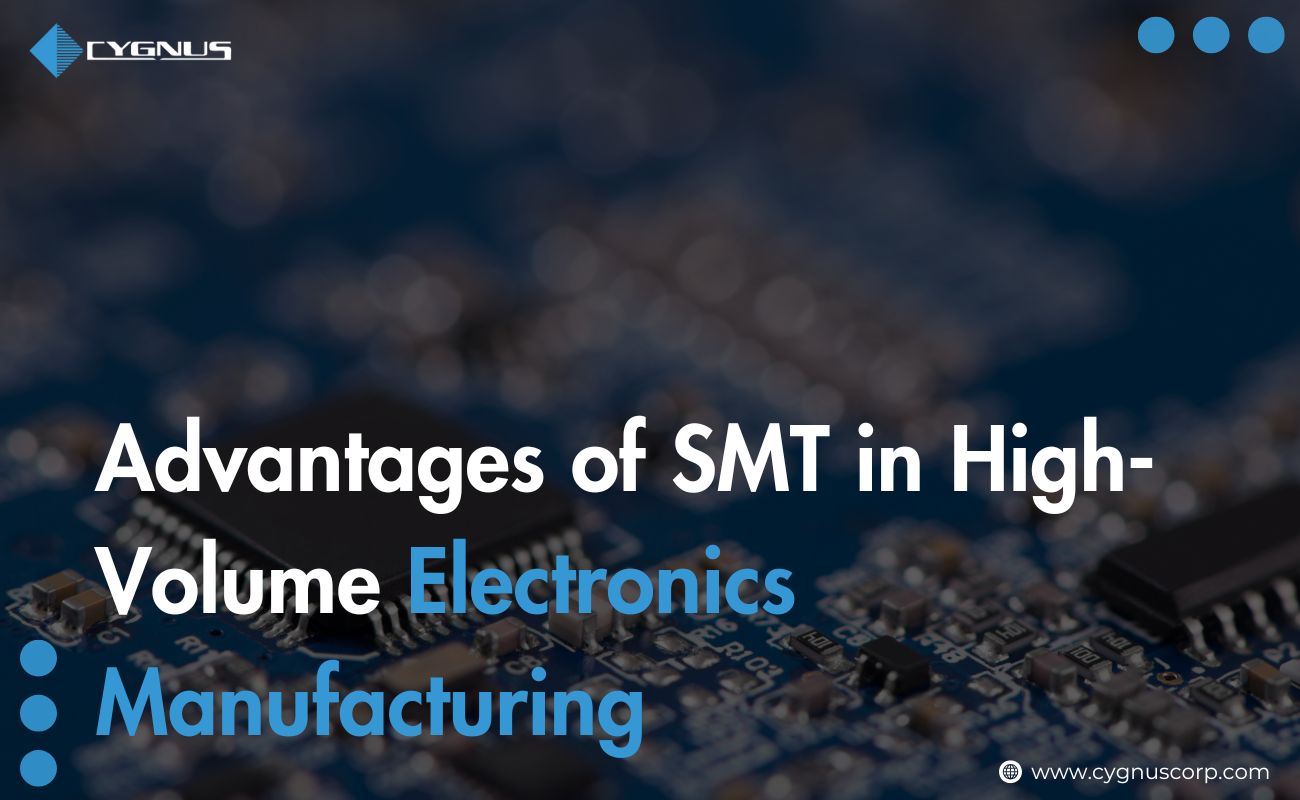Building millions of devices isn’t just about speed — it’s about doing it smarter, smaller, and stronger. That’s exactly what Surface Mount Technology (SMT) makes possible. By allowing tiny components to be placed directly onto circuit boards, SMT has completely changed the way electronics are designed and manufactured.
From smartphones and laptops to automotive systems and medical devices, this method has made mass production faster, more reliable, and more cost-effective than ever before.
In this blog, we’ll break down the advantages of SMT in high-volume electronics manufacturing and explain why it’s the driving force behind today’s high-performance, affordable technology.
What is Surface Mount Technology (SMT)?
Surface Mount Technology, or SMT, is a method where electronic components are mounted directly onto the surface of printed circuit boards (PCBs). Unlike traditional Through-Hole Technology (THT), which involves inserting component leads into drilled holes, SMT simplifies the process by placing tiny components directly on the board surface. This shift has unlocked a long list of Surface Mount Technology benefits, especially for companies aiming to scale their operations.
Thanks to SMT, manufacturers can pack more functionality into smaller devices — a crucial factor in today’s electronics market dominated by smartphones, laptops, medical devices, and wearables.
Why High-Volume Electronics Manufacturing Needs SMT
The demand for faster, more efficient electronics manufacturing has never been higher. Whether it’s consumer electronics, automotive systems, or industrial IoT devices, companies need high-volume PCB assembly services that deliver both speed and reliability.
This is where the benefits of surface mount technology become critical. SMT enables:
- Faster production cycles
- Lower production costs
- Higher product consistency
- Easier scaling from prototype to mass production
Without SMT, meeting today’s demand for affordable, high-performance electronics would be nearly impossible.
Top Advantages of SMT in High-Volume Manufacturing:
Let’s dive deeper into the main advantages of SMT that make it the go-to choice for modern mass production.
1. Higher Production Speed:
SMT machines can place thousands of components onto a PCB within minutes. This automation significantly boosts throughput, helping businesses meet deadlines for large orders. High-speed placement is a core SMT advantage for PCB manufacturing today.
2. Smaller and Lighter PCBs:
One of the standout Surface Mount Technology benefits is its support for compact designs. Because components are directly mounted on the board without the need for long leads, devices can be made smaller, lighter, and more efficient perfect for smartphones, tablets, and wearables.
3. Lower Manufacturing Costs:
SMT in electronics production offers clear cost benefits:
- Reduced drilling and material usage
- Lower labor costs due to automation
- Less need for manual soldering
This makes high-volume PCB assembly services more affordable, especially for industries producing thousands or millions of units.
4. Greater Design Flexibility:
SMT allows engineers to place components on both sides of a PCB and arrange them in tighter spaces. This flexibility opens up new design possibilities and allows for more complex, multifunctional devices — a major benefit of surface mount technology driving innovation.
5. Improved Reliability and Performance:
Shorter electrical paths between components lead to faster signal transmission and better overall performance. Additionally, SMT-mounted components handle vibrations and mechanical stresses better than their THT counterparts — making them ideal for automotive and industrial applications.
6. Easier Mass Production Scaling:
One of the biggest advantages of SMT in high-volume electronics manufacturing is how easily it scales.
SMT assembly lines can be adapted quickly for larger batches or new product designs, ensuring manufacturers stay agile in a competitive market.
SMT vs. THT: Quick Comparison for Mass Production:
| Feature | SMT | THT |
| Component Placement | Surface-mounted | Leaded through-hole |
| Board Size | Smaller and lighter | Bulkier |
| Production Speed | Very fast | Slower |
| Cost Efficiency | High | Lower for prototypes |
| Vibration Resistance | Strong | Moderate |
| Best For | High-volume manufacturing | Specialized, high-durability products |
For companies prioritizing SMT for high-volume manufacturing, SMT clearly delivers unmatched advantages.
Industries Benefiting from High-Volume SMT Assembly:
SMT has revolutionized several industries:
- Consumer Electronics: Smartphones, laptops, tablets
- Automotive: Advanced Driver-Assistance Systems (ADAS), infotainment systems
- Medical Devices: Portable monitors, diagnostic equipment
- Industrial Automation: IoT devices, robotics
Each of these sectors relies on SMT in electronics production to keep costs low, quality high, and innovations rolling out quickly.
Challenges of SMT in Mass Production (and Solutions):
While SMT offers huge benefits, it does come with a few challenges:
- Placement Precision: Components are tiny and require accurate placement.
- Inspection Requirements: Tiny solder joints are harder to inspect manually.
- Thermal Management: Dense designs may require better heat management strategies.
Solutions include:
- Automated Optical Inspection (AOI) systems
- X-ray inspection for hidden solder joints
- Careful PCB layout and design for heat dissipation
By addressing these issues, manufacturers can fully maximize SMT advantages for PCB manufacturing.
Final Thoughts: Why SMT is the Backbone of High-Volume Electronics
The Advantages of SMT in High-Volume Electronics Manufacturing are clear: faster production, smaller devices, lower costs, and higher reliability. The Surface Mount Technology benefits we see today are driving the electronics industry forward, enabling groundbreaking innovations and meeting the insatiable global demand for smart devices.
For any business looking into high-volume PCB assembly services, choosing SMT isn’t just an option — it’s a necessity.
As devices continue to shrink and functionality continues to grow, SMT’s role in modern electronics production will only become more critical.
FAQs
Q1: Why is SMT preferred over THT in mass production?
SMT offers faster production speeds, reduced costs, and smaller PCB sizes — all crucial for scaling mass production efficiently.
Q2: How does SMT reduce manufacturing costs?
By eliminating the need for drilling and reducing manual assembly steps, SMT significantly cuts material and labor costs.
Q3: Is SMT suitable for all types of electronics manufacturing?
Mostly yes. SMT suits the majority of modern electronics, though THT is still used for products requiring extreme durability, like aerospace components.
Q4: What challenges does SMT face in high-volume production?
Challenges include tiny component placement precision and inspection, but these are easily managed with automation technologies like AOI and X-ray systems.




